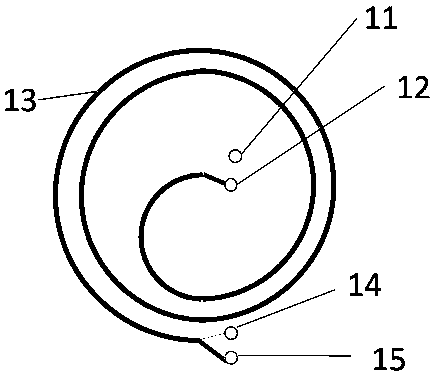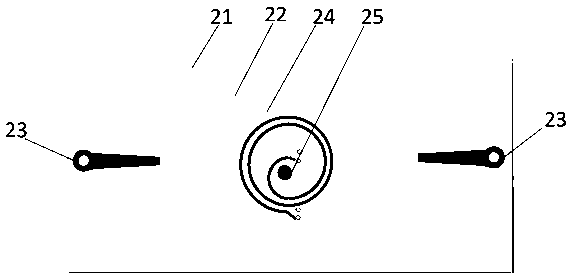Trace cell capturing system based on microfluidic and immune magnetic separation double policy
An immunomagnetic separation and microfluidic technology, applied in the field of cell separation, can solve the problems of missed detection of tumor cells, complex chip structure, high processing and operation process costs, and achieve the effects of convenient operation, cost reduction, and simple structure
- Summary
- Abstract
- Description
- Claims
- Application Information
AI Technical Summary
Problems solved by technology
Method used
Image
Examples
Embodiment 1
[0028] A trace cell microfluidic chip capture system for the separation of circulating tumor cells in peripheral blood, the system includes a spiral microfluidic chip and a chip holder containing a magnet; the microfluidic chip includes a sample inlet (11 ), the sheath liquid inlet (12), the spiral flow channel (13), the trace cell collection outlet (14) and the waste liquid port (15); the spiral flow channel is composed of a single helical channel, and the single The inlet of the helical channel is located near the center of the circular helical channel, and enters the helical microchannel through the semicircular initial channel. The end of the channel contains two outlets to collect trace cells and waste liquid in the sample respectively. The chip holder is used to fix the chip, including the chip holder base (21), the chip groove (22), the chip fixing shrapnel (23) and the magnet (25), the circular magnet is fixed in the groove of the chip holder, and the position Correspo...
Embodiment 2
[0038] A trace cell microfluidic chip capture system is used for the separation of circulating tumor cells in pleural effusion. The device is the same as in Example 1, and the separation steps are as follows.
[0039] (1) After centrifuging 3 mL of the pleural effusion sample to be tested at 1500 rpm, remove the supernatant, redisperse in 0.5 mL of LPBS buffer, and then add magnetic beads coated with anti-EpiCAM antibody and anti-Her2 antibody (Mitten, Germany) Nii), incubated at room temperature for 1h, as the injection sample.
[0040] Using a syringe pump, inject the cell sample treated in step (1) into the chip at a rate of 0.5 mL / h from the sample inlet of the chip through the catheter, and inject PBS buffer into the chip at a rate of 2.5 mL / h through the sheath fluid inlet. According to the difference in the size and density of some cells, the inertial focusing separation of trace cells is realized in the single-helix chip, and the immunomagnetic separation of trace cell...
PUM
 Login to View More
Login to View More Abstract
Description
Claims
Application Information
 Login to View More
Login to View More - R&D Engineer
- R&D Manager
- IP Professional
- Industry Leading Data Capabilities
- Powerful AI technology
- Patent DNA Extraction
Browse by: Latest US Patents, China's latest patents, Technical Efficacy Thesaurus, Application Domain, Technology Topic, Popular Technical Reports.
© 2024 PatSnap. All rights reserved.Legal|Privacy policy|Modern Slavery Act Transparency Statement|Sitemap|About US| Contact US: help@patsnap.com









